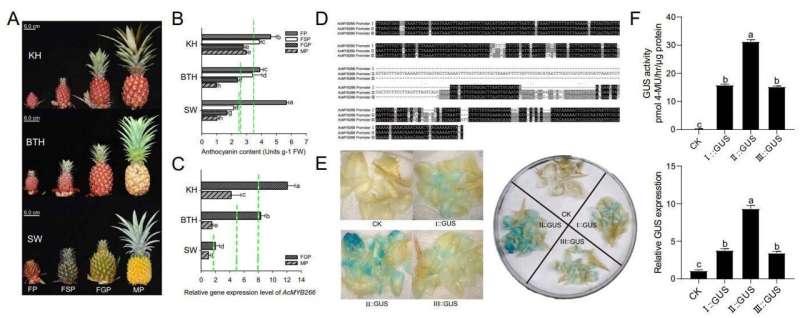This article has been reviewed according to Science X's editorial process and policies. Editors have highlighted the following attributes while ensuring the content's credibility:
fact-checked
peer-reviewed publication
proofread
Scientists uncover the molecular mechanism behind pineapple peel coloration

Pineapple peel coloration, especially the red hue, significantly enhances its commercial and aesthetic value. However, the genetic mechanisms driving this trait are not well understood, complicating breeding efforts for red-skinned varieties.
Previous studies have identified various genes involved in anthocyanin synthesis, but their precise regulatory roles remain unclear. Due to these challenges, an in-depth investigation into the genetic factors influencing pineapple peel coloration is essential to develop high-quality varieties that meet market demands.
Researchers from the South China Agricultural University, Tropical Crops Genetic Resources Institute, Chinese Academy of Tropical Agricultural Sciences, and Guangdong Eco-Engineering Polytechnic published their findings on April 25, 2024, in Horticulture Research.
The study investigates the role of AcMYB266, a transcription factor, in regulating the red coloration of pineapple peel by promoting anthocyanin synthesis. This discovery provides new insights into the genetic mechanisms behind fruit peel pigmentation, with significant implications for breeding red-skinned pineapple varieties.
The research team identified AcMYB266 as a key transcription factor specifically expressed in the pineapple peel, regulating anthocyanin accumulation. Through transgenic experiments in pineapple, Arabidopsis, and tobacco, they demonstrated that overexpression of AcMYB266 leads to increased anthocyanin levels, resulting in red pigmentation.
The study also found that variations in the promoter sequences of AcMYB266 contribute to the different red coloration patterns observed in various pineapple varieties. Notably, AcMYB266 is part of a unique gene cluster in Ananas species, which includes other MYB genes that regulate anthocyanin synthesis in different tissues, such as leaves and petals.
This gene cluster represents an interesting case of subfunctionalization after gene duplication, where each gene has evolved to regulate anthocyanin accumulation in specific tissues. These findings offer valuable insights for breeding high-quality red-skinned pineapple varieties.
Dr. Chengjie Chen, one of the study's researchers, stated, "Our findings on AcMYB266 provide valuable insights into the genetic regulation of anthocyanin accumulation in pineapple. This not only enhances our understanding of fruit coloration but also opens new avenues for breeding programs aimed at producing high-quality red-skinned pineapple varieties."
The identification of AcMYB266 and its role in anthocyanin accumulation holds significant implications for pineapple breeding. By manipulating this gene, it is possible to develop new pineapple varieties with enhanced aesthetic and nutritional value, meeting both market demand and consumer preferences.
This study also serves as a model for exploring gene subfunctionalization in other plant species, potentially leading to broader agricultural advancements.
More information: Wei Zhang et al, AcMYB266, a key regulator of the red coloration in pineapple peel: a case of subfunctionalization in tandem duplicated genes, Horticulture Research (2024). DOI: 10.1093/hr/uhae116
Journal information: Horticulture Research
Provided by South China Agricultural University
















